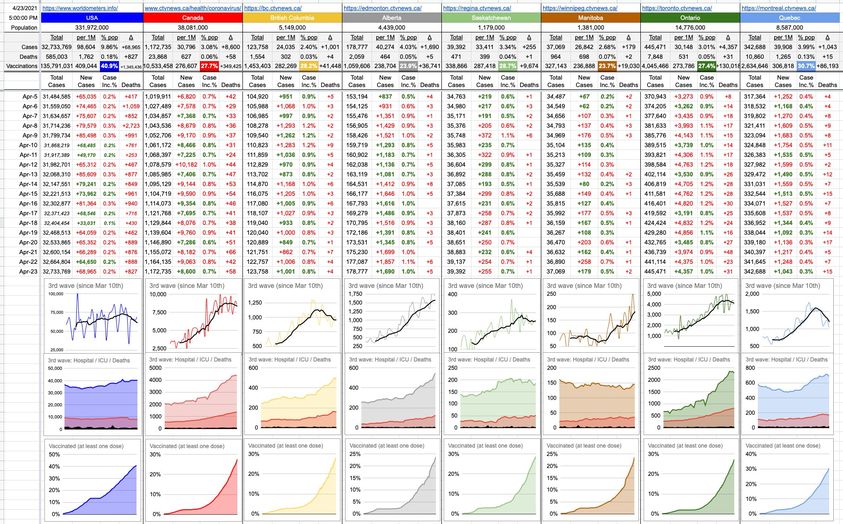I can’t say I’m feeling particularly well today… but, on the flipside, it’s never felt so good to not feel so good. Hit me with the side-effects… I’m happy to have them! Headache, sore arm, zero energy, random little pains. It’s all good.
Here’s what’s not so good… if I told you the average C19 hospitalizations in B.C. over the last 5 weeks have looked like this:
Five weeks ago: 425
Four weeks ago: 441
Three weeks ago: 456
Two weeks ago: 483
A week ago: 502
… you’d say jeez… that’s not good. And it’s not… but what’s worse is that those aren’t weekly averages; they’re the daily numbers going back five days.
Let’s rewrite the day-over-day growth as a percentage, leading up to yesterday:
4/18 – 4/19: 3.8%
4/19 – 4/20: 3.4%
4/20 – 4/21: 5.9%
4/21 – 4/22: 3.9%
The average of that is 4.3%, but let’s just call it 4%.
At this pace, here’s how many hospital beds would be needed by these dates:
4/26: 611
4/30: 715
5/07: 940
5/14: 1,237
Fortunately, that’s unlikely to happen… but there’s no reason to think it wouldn’t have if things had remained unchecked. If people wonder why “senseless” restrictions get imposed, it’s precisely to avoid scenarios like this.
From the time a case is diagnosed to the time they make it to hospital, it’s about 10 to 14 days. Accordingly, the alarming numbers above are a reflection of that really bad stretch in the second week of April, and things have improved slightly since. Numbers have come off a bit, and today saw a 3.2% *drop* in hospitalizations… but both hospitalizations and ICU numbers are near all-time highs.
The travel restrictions imposed today raise lots of questions… and I would suggest everyone simply drop any questions that contains the words “technically speaking”. It would take a lot longer than the length of these restrictions (to the end of the May long-weekend) to come up with rules and wording that everyone would agree with. So, forget the wording… and just think about the spirit of what’s trying to be achieved here – which is to not spread cases from region to region, hot-spot to hot-spot. And when you don’t know where those regions or hot-spots are likely to pop-up, you mitigate for all of them.
I totally agree with the intent of these measures because it’s not hard to see the evolution of these numbers, and something needs to be done… but I do wonder how effective they’ll be. We will not have militant checkpoints and rogue cops. We will simply have, as usual, things being left up to us. I guess we’ll see how that pans out. Other words I really don’t want to hear one day are… “If only we’d…”



The HK Daily Report (1.25 min read)
Hurts so goooood!
Hope you feel better Horatio…
Hope will be seeing the benefits of the increase vaccination rate , in a very near future. In the meantime….. “seat tight”!
You will be like new tomorrow 😁
Craig George
In the first wave, the majority of the people who died lived in nursing homes and never went to hospital. Now, the deaths are mostly occurring in hospital. Had those people survived, the number of people in hospital (and in ICU) would be higher. The number of people in ICU at any one time is increasing because many critically ill survivors spend weeks or months in the ICU.
Yes Horatio, Brenda did not feel good at all… She got the AZ on Monday and finally today she seems to feel better.. the Pfizer for me on the other hand, no side effects. Nothing.
Take care and feel better soon.
Mejórate pronto!